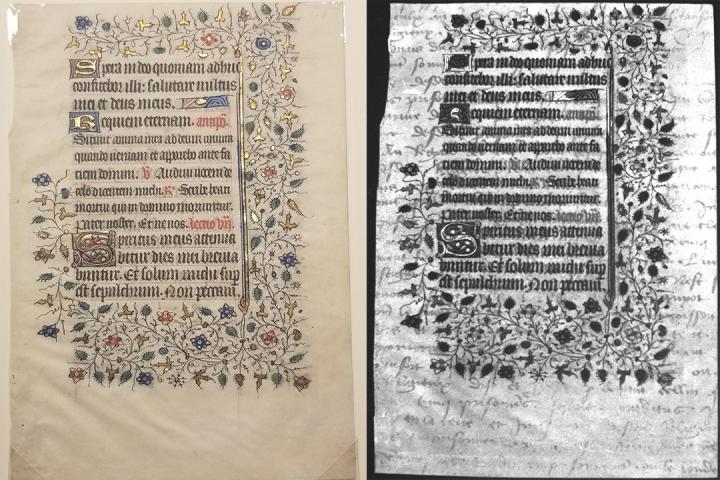Imaging system they built as freshmen reveals new information about Otto Ege Collection

Credit: RIT
Rochester Institute of Technology students discovered lost text on 15th-century manuscript leaves using an imaging system they developed as freshmen. By using ultraviolet-fluorescence imaging, the students revealed that a manuscript leaf held in RIT’s Cary Graphic Arts Collection was actually a palimpsest, a manuscript on parchment with multiple layers of writing.
At the time the manuscript was written, making parchment was expensive, so leaves were regularly scraped or erased and re-used. While the erased text is invisible to the naked eye, the chemical signature of the initial writing can sometimes be detected using other areas of the light spectrum.
“Using our system, we borrowed several parchments from the Cary Collection here at RIT and when we put one of them under the UV light, it showed this amazing dark French cursive underneath,” said Zoë LaLena, a second-year imaging science student from Fairport, N.Y., who worked on the project. “This was amazing because this document has been in the Cary Collection for about a decade now and no one noticed. And because it’s also from the Ege Collection, in which there’s 30 other known pages from this book, it’s really fascinating that the 29 other pages we know the location of have the potential to also be palimpsests.”
The imaging system was originally built by 19 students enrolled in the Chester F. Carlson Center for Imaging Science’s Innovative Freshman Experience, a yearlong, project-based course that has the imaging science, motion picture science, and photographic sciences programs combine their talents to solve a problem.
When RIT switched to remote instruction in March due to the coronavirus outbreak, the students were unable to finish building it, but thanks to a donation from Jeffrey Harris ’75 (photographic science and instrumentation) and Joyce Pratt, three students received funding to continue to work on the project over the summer. Those three students–LaLena; Lisa Enochs, a second-year student double majoring in motion picture science and imaging science from Mississauga, Ontario; and Malcom Zale, a second-year motion picture science student from Milford, Mass.–finished assembling the system in the fall when classes resumed and began analyzing documents from the Cary Collection.
Steven Galbraith, curator of the Cary Graphic Arts Collection, said he was excited they discovered the manuscript leaf was a palimpsest because similar leaves have been studied extensively by scholars across the country, but never tested with UV light or fully imaged.
Collector, educator, and historian Otto Ege made leaf collections out of medieval manuscripts that were damaged or incomplete and sold them or distributed them to libraries and special collections across North America, including to the Cary Collection. Galbraith said he’s excited because it means that many other cultural and academic institutions with Ege Collection leaves now may have palimpsests in their collection to study.
“The students have supplied incredibly important information about at least two of our manuscript leaves here in the collection and in a sense have discovered two texts that we didn’t know were in the collection,” said Galbraith. “Now we have to figure out what those texts are and that’s the power of spectral imaging in cultural institutions. To fully understand our own collections, we need to know the depth of our collections, and imaging science helps reveal all of that to us.”
The students are interested to see if more manuscript leaves from Ege collections across the country are palimpsests. They imaged another Ege Collection leaf at the Buffalo and Erie County Public Library that turned out to be a palimpsest and are reaching out to other curators across the country. As they begin stitching the lost text back together, paleographers can examine the information they contain.
The students have been selected to share their results at the 2021 International Congress on Medieval Studies and also plan to present the project at next year’s Imagine RIT: Creativity and Innovation Festival.
###
VIDEO AVAILABLE:
https:/
Media Contact
Luke Auburn
[email protected]
Original Source
https:/




